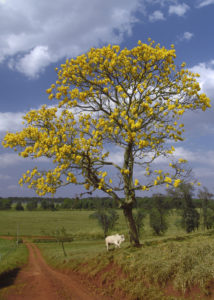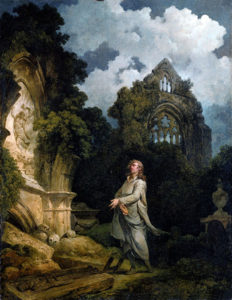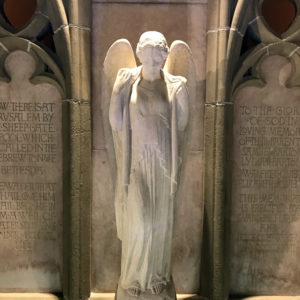Here in Lake Worth, in this land of subtle weather transitions, it’s easy to forget what season of the year it is. There is a Yellow Tabebuia tree in our front yard that is both shedding its leaves and bursting into yellow blossoms, as it is wont to do in the spring… and that alone gets confusing. Each day after work I walk up the front path to the door, leaves crunching underfoot. Look up, and it looks like spring, look down, it looks more like fall. But that’s the way trees operate here in Florida. And I bought some really good crisp Macintosh apples from the market last week, which also makes it feel like fall. They’re from Michigan, according to the sticker that’s on each and every apple, so that means they were harvested last September or October probably, and yet they’re firm and crispy and juicy… and this deliciousness, too, has contributed to my confusion of late.
But here are the facts, probably more obvious to those of you in more northern climes: Spring is here, and summer is on its way. And come Sunday, with the end of April, we come to another shift in the seasonal round of the year. By traditional reckoning of time, the wheel turns a notch toward summer. We are now halfway between the spring equinox and the summer solstice, and we approach, in the Celtic tradition, the cross-quarter day directly opposite Samhain, which brought us our Halloween traditions. The Celts considered that night the start of winter. And now, at its opposite side of the year, comes Beltane, which brings the start of summer. (Both, by the way, are pronounced not as they appear: Samhain is pronounced sow-an with an emphasis on sow; Beltane is pronounced bowl-tan-a with an emphasis on bowl.)
These old Celtic things are distinctly European and truth be told, so are the celebrations that welcome summer at the start of May, for they did not translate well at all to the New World, which is unfortunate for us who live here. This time of year is a big deal in most of Europe, especially in the North Countries, where summer is so welcome after so many months of cold. And so on this Eve of May throughout the Norse countries there will be bonfires and there will be dinners of hearty bread and gravlax, a cured smoked salmon, and sparkling wine will be flowing. In the Dutch and German countries, it is Walpurgisnacht, Walpurgis Night, also designed to ring in summer. There is a long tradition connecting witches with Walpurgisnacht, which probably comes from the power of literature: Goethe titled one of the scenes of Faust “Walpurgisnacht” and in it, the witches hold a frenzied meeting upon the Brocken, the highest peak of the Harz Mountains in Northern Germany; the scene takes place on the Eve of May amongst the bonfires of Walpurgisnacht. This could be yet another reason why this holiday is not very big here in the States: we have been handed a long, misinformed history when it comes to witches and the old earthbound religions.
Walpurgis Night takes us into May Day, and celebrations by light of day. Picnics are common on the First of May throughout Scandinavia, and in England, the May Day celebration begins early in the morning. It is, traditionally, the day that folks go out into the woods for amorous adventures. Robert Herrick, the great 17th century English poet whose words we invoke often in this Book of Days, offers us a glimpse of the day in his poem “Corinna’s Going a Maying,” as he prods Corinna to awake, be brief in praying, and worry not about her hair and dress, for time is wasting, and we must head out and go a Maying. Out to the woods, to gather hawthorn flowers and Lord knows what else all these lads and lasses will be doing, but one thing is for sure: They’ll be coming back with gowns once white, now stained with green. May Day was an invitation to romantic love. The earth, fully awake from its winter slumber, and we awake with it. The maypole, so potently symbolic: it took the hands of many strong men to plant it in the ground, erect and pointing toward the sky. You might imagine (and you’d be right) that the Puritans hated May Day as much as they hated Christmas. During their time in power in England, they banned Christmas and they banned maypoles, too.
I’m sure the Puritans would’ve hated this blog, too. My advice to you this Walpurgisnacht? Follow not their lead. Instead, get you to your local fish market and ask for gravlax or any smoked salmon (preferably fish they’ve smoked right there at the shop). If you’re in the neighborhood of a Scandinavian bakery, get you a fresh baked loaf of hearty dark rye bread (it’s nothing like the stuff in the supermarket). Hard boiled eggs and dill and lemon wedges will make a nice accompaniment. Don’t forget the sparkling wine. And mark the night by lighting a fire outdoors, or maybe just a candle or a lantern. Some poetry by Robert Herrick wouldn’t hurt at all. His is the kind of poetry you’ll want to read aloud. Read it to yourself or read it to someone you love, and if you can convince them to go a Maying with you, all the better. If in the morning you find grass stains on your clothes, you’ll be in the company of folks who have loved this night and this morning since time immemorial. Folks who love love and the things of this world and who wish to make of it a heaven on earth. That’s some fine company.
Image of a Yellow Tabebuia tree, just like the ones found here in Lake Worth, taken in Brazil by José Reynaldo da Fonseca. Tabebuia is a neotropical genus of about 100 species in the tribe Tecomeae of the family Bignoniaceae. The species range from northern Mexico and southern Florida south to northern Argentina, including the Caribbean islands of Puerto Rico, Hispaniola (Dominican Republic, Haiti), Jamaica, Trinidad & Tobago, and Cuba. [Public domain] via Wikimedia Commons.


